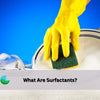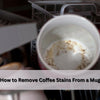How to Get Rid of Mould in Your Bathroom
- by Brodie Cook

Why Mould is a Problem and Where it Grows
Bathrooms are the perfect spot for mould to grow, especially in the shower. Warm and damp conditions after each use allow moisture to build up. Poor airflow makes it even easier for mould to spread.
Mould also causes health problems. It can trigger breathing problems and irritate the skin. Over time, it damages grout, tiles, and silicone seals. If ignored, it spreads further and can lead to costly repairs.
Grout, tiles, and silicone seals are common mould hotspots as they trap moisture. Walls and ceilings can also be at risk if ventilation is poor. A musty smell is often the first sign. Using natural solutions is a safe and effective way to treat and prevent mould in the shower and other areas.
Many people believe bleach is the best way for mould removal. But it does not treat the root of the problem. The Australian Environmental Mycology Laboratory advises using a safer and more effective method. They recommend cleaning the area with a vinegar and water solution. We'll talk more about that later.
Identifying and Diagnosing the Cause of Mould

To spot mould, look for signs like black or green patches, discolouration, musty smells, or damp areas. Mould thrives in places with leaks, trapped moisture, and poor ventilation. To prevent mould from coming back, it's important to fix the root cause, such as sealing leaks and improving airflow.
Mould grows where there's excess moisture, often due to leaks, trapped water, or poor ventilation. Leaks let water into walls, ceilings, and floors, while trapped moisture builds up in areas like bathrooms and kitchens. Poor airflow keeps the air damp. These conditions create the perfect environment for mould. To stop mould from returning, seal any leaks, improve ventilation, and reduce humidity.
Tools and Natural Cleaning Solutions

Gear Required
1. Gloves, mask, and goggles: Wear these to protect your skin and lungs when handling mould.
2. Spray bottle: Use this to apply your cleaning solution.
3. Soft-bristle brush: Great for gently scrubbing surfaces.
4. Microfibre cloth: Use this to wipe down cleaned areas.
Steps to Remove Mould in the Shower

We will use white vinegar for all surfaces to get rid of mould. This is a natural and effective solution to remove the mould. After this, you can treat most surfaces with Lucent Globe Multi-Purpose Cleaning Sheets.
If the vinegar solution does not completely remove the mould, you can try a stronger alternative. Use a hydrogen peroxide solution or baking soda paste as a fallback plan.
Bathroom Ceiling and Walls
Spray vinegar directly onto mouldy areas on the ceiling and walls. Ensure the surface is evenly coated. Let the solution sit for 15-20 minutes to loosen the mould and kill mould spores. Use a sponge or soft cloth to wipe the surface clean. For stubborn stains, scrub the mould gently with a soft-bristle brush. Rinse with water and dry thoroughly.
TIP: Watch out when spraying this on the ceiling as some drops can fall back! So make sure to wear your protective gear in any of the steps described here!
Shower Grout and Bathroom Tiles
Tip: Clean the tiles first and then the grout! Don't do it at the same time.
For grout, skip the vinegar and use a baking soda paste or hydrogen peroxide solution. These work better on porous surfaces, killing mould at its roots. Apply the solution, let it sit for 15-20 minutes, then brush to scrub with a toothbrush or scrush. Rinse with warm water and dry thoroughly.
For tiles, vinegar works perfectly since they are non-porous. Spray undiluted vinegar directly onto the tiles and let it sit for 15-20 minutes. Wipe clean with a sponge or cloth, then rinse and dry completely. This keeps your tiles mould-free and looking fresh.
Shower Silicone Sealants
Spray vinegar onto the silicone seals around the shower. Ensure all spots are covered. Let the vinegar sit for 15-20 minutes to loosen the mould. Scrub gently with a toothbrush or sponge to lift the mould. Rinse thoroughly with warm water and dry completely.
Shower Drains and Vents
Pour vinegar directly into the shower drain. Let it sit for an hour or more to kill mould and bacteria. Flush the drain with warm water to rinse away debris. For vent covers, spray the vinegar and scrub gently with a sponge or scrush to remove mould and stains. Rinse thoroughly and dry before reattaching.
Shower Curtains
Remove the mouldy curtain and soak it in undiluted vinegar for 20 minutes. Scrub mouldy spots with a sponge or soft brush. Rinse thoroughly with water and hang the curtain to dry completely before reattaching.
Preventing Mould Growth

Keep the Area Dry
Use a towel or squeegee after each shower to wipe away any extra water. This helps prevent moisture build-up and mould growth.
Improve Ventilation
To reduce humidity, open windows or use an exhaust fan. This will help improve airflow and keep the bathroom dry, making it harder for mould to grow.
Fix Leaks Quickly:
Clean Regularly
To prevent mould, clean your bathroom regularly. Use the Multi Purpose Cleaning Sheets for a finish. This helps remove any moisture and grime that can encourage mould growth, keeping the space fresh and mould-free
Use Moisture Absorbers
Sprinkle baking soda in damp areas to absorb moisture and prevent mould. Leave it for a few hours, then vacuum or wipe it away. You can also place it in an open box in the bathroom.
Use a Dehumidifier
Turn on a dehumidifier overnight or after showers to reduce moisture and prevent mould. Remember to empty the water tank regularly.
FAQ
Will Bathroom Paint Stop Mould?
Mould-resistant bathroom paint can help reduce mould growth but won’t stop it completely. To prevent mould, fix leaks, improve ventilation, and keep the area dry. Paint works best as part of an overall mould-prevention plan.
Is Bathroom Mould Dangerous?
Yes, bathroom mould can be harmful, especially for those with allergies, asthma, or weak immunity. It can cause respiratory issues and skin irritation. Clean it promptly and fix moisture or ventilation problems to stay safe.
Can Bleach kill Black Mould?
Most people think bleach gets rid of mould, right? You pour it on, it disappears, and then a few weeks later, it is back. That is because bleach does not actually kill mould. It only strips away the colour, so it looks like it is gone.
The mould treats bleach like an attack and produces enzymes to fight it off. These enzymes even turn the bleach into a food source. So instead of solving the problem, you are feeding the mould. After a few weeks, the colour comes back, and the mould is visible again. It was never really gone. (source: Myths About Mould)

 Dishwashing
Dishwashing Laundry
Laundry Bundles
Bundles Surfaces
Surfaces Toilet
Toilet Handsoap
Handsoap Multi-Purpose
Multi-Purpose Floor
Floor



